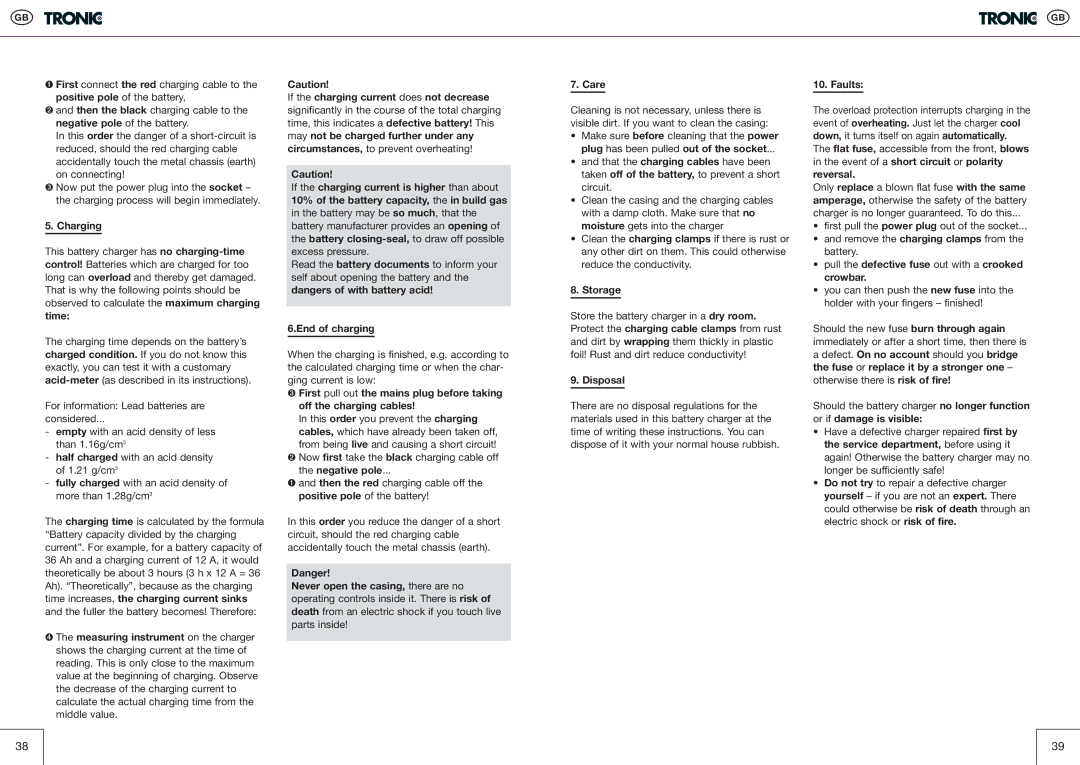
➊First connect the red charging cable to the positive pole of the battery,
➋and then the black charging cable to the negative pole of the battery.
In this order the danger of a
➌Now put the power plug into the socket – the charging process will begin immediately.
5. Charging
This battery charger has no
time:
The charging time depends on the battery’s charged condition. If you do not know this exactly, you can test it with a customary
For information: Lead batteries are
considered...
-empty with an acid density of less than 1.16g/cm3
-half charged with an acid density of 1.21 g/cm3
-fully charged with an acid density of more than 1.28g/cm3
The charging time is calculated by the formula “Battery capacity divided by the charging current”. For example, for a battery capacity of 36 Ah and a charging current of 12 A, it would theoretically be about 3 hours (3 h x 12 A = 36 Ah). “Theoretically”, because as the charging time increases, the charging current sinks and the fuller the battery becomes! Therefore:
➍The measuring instrument on the charger shows the charging current at the time of reading. This is only close to the maximum value at the beginning of charging. Observe the decrease of the charging current to calculate the actual charging time from the middle value.
Caution!
If the charging current does not decrease
significantly in the course of the total charging time, this indicates a defective battery! This
may not be charged further under any
circumstances, to prevent overheating!
Caution!
If the charging current is higher than about 10% of the battery capacity, the in build gas
in the battery may be so much, that the battery manufacturer provides an opening of the battery
Read the battery documents to inform your self about opening the battery and the
dangers of with battery acid!
6.End of charging
When the charging is finished, e.g. according to the calculated charging time or when the char- ging current is low:
➌First pull out the mains plug before taking off the charging cables!
In this order you prevent the charging cables, which have already been taken off, from being live and causing a short circuit!
➋Now first take the black charging cable off the negative pole...
➊and then the red charging cable off the positive pole of the battery!
In this order you reduce the danger of a short circuit, should the red charging cable accidentally touch the metal chassis (earth).
Danger!
Never open the casing, there are no operating controls inside it. There is risk of death from an electric shock if you touch live parts inside!
7. Care
Cleaning is not necessary, unless there is visible dirt. If you want to clean the casing:
•Make sure before cleaning that the power plug has been pulled out of the socket...
•and that the charging cables have been taken off of the battery, to prevent a short circuit.
•Clean the casing and the charging cables with a damp cloth. Make sure that no moisture gets into the charger
•Clean the charging clamps if there is rust or any other dirt on them. This could otherwise reduce the conductivity.
8. Storage
Store the battery charger in a dry room. Protect the charging cable clamps from rust and dirt by wrapping them thickly in plastic foil! Rust and dirt reduce conductivity!
9. Disposal
There are no disposal regulations for the materials used in this battery charger at the time of writing these instructions. You can dispose of it with your normal house rubbish.
10. Faults:
The overload protection interrupts charging in the event of overheating. Just let the charger cool down, it turns itself on again automatically.
The flat fuse, accessible from the front, blows in the event of a short circuit or polarity
reversal.
Only replace a blown flat fuse with the same amperage, otherwise the safety of the battery charger is no longer guaranteed. To do this...
•first pull the power plug out of the socket...
•and remove the charging clamps from the battery.
•pull the defective fuse out with a crooked crowbar.
•you can then push the new fuse into the holder with your fingers – finished!
Should the new fuse burn through again immediately or after a short time, then there is a defect. On no account should you bridge the fuse or replace it by a stronger one – otherwise there is risk of fire!
Should the battery charger no longer function or if damage is visible:
•Have a defective charger repaired first by the service department, before using it again! Otherwise the battery charger may no longer be sufficiently safe!
•Do not try to repair a defective charger yourself – if you are not an expert. There could otherwise be risk of death through an electric shock or risk of fire.
38
39
